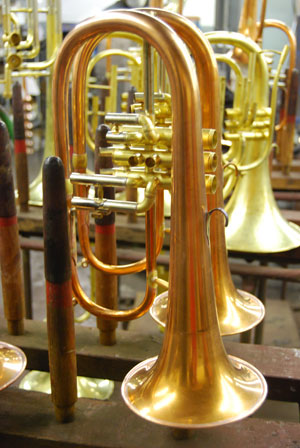Can you remember a time when you effortlessly fingered a new trumpet’s keys or jammed on a drum set using smooth, unworn sticks? Those finished products were once nothing more than rough wood or sheets of metal. Here, you can get a close-up look inside the instrument and accessory creation process—from the design stage and material selection to field testing and packaging.
The spark that inspires the invention of a new instrument occurs when a musician, a member of an instrument production company or a customer becomes frustrated with the available products and begins to dream up alternatives.
For instance, percussionist Vic Firth, founder of the Boston-based sticks and mallets company by the same name, began whittling his own sticks while he was a member of the Boston Symphony. He had been dissatisfied with the available options and so solved the problem with his own hands—literally.
However, creating an instrument or accessory that has never been made before is no simple task. For an innovative product idea to be fully realized, a manufacturer must go through a number of production stages, beginning with design.
The Design Stage
Ideas for new instruments and accessories come from a number of sources. Sometimes a customer submits a suggestion to a company website. Sometimes an industry insider has an epiphany and begins to sketch a design on a cocktail napkin— which was how Bruce Jacoby, manager of marching and education at Remo in Valencia, Calif., conceived the idea of the PowerMax Pre-Muffled Marching Bass Drumhead with a few colleagues. And many times, companies rely on professional musicians to gauge unmet needs.
“Our designs, certainly in the marching world, are led 100% by the artists out there using [our products],” says Colin Schofield, vice president of marketing worldwide for Premier Percussion. “They are the ones experiencing the issues in the field and come back to us saying, ‘It would be great if this drum could do this, if this lug could do this …’ ‘This is the problem with this drum …’ We are continually moving forward based on their experiences in the field.”
Artists not only inspire ideas for new products, but they may also work closely with a company throughout the entire production process. They include the many musicians who founded or are employed full time at instrument and accessory production companies in executive levels, sales, marketing, education and more.
Charles Hargett, sales and marketing manager at Kanstul Musical Instruments in Anaheim, Calif., for instance, graduated with a music education degree and played trumpet in a band for years. Then Hargett decided to pursue a career in sales, which eventually led him to his current job at Kanstul. Manufacturers benefit from having knowledgeable instrumentalists on staff because they can suggest product improvements based on first-hand experience.
Manufacturers also consult with full-time professional musicians on an as-needed basis. For example, Bil Jackson, an artist design consultant for Yamaha Corporation of America, is currently working with Tomoji Hirakata, lead woodwind designer at Yamaha’s custom shop in New York, on an “A” clarinet that combines the best qualities of a French and German bore. Hirakata sends prototypes to Jackson’s home in Colorado—where he has been a clarinetist for the Colorado Symphony Orchestra for 26 years—and Jackson sends them back with suggestions for improvement. “Tomoji will make changes to the dimensions of the bore, the dimensions of the tone holes, etc.,” Jackson says. “There are a myriad of changes that can make a world of difference. You have to take baby steps because changing one thing can make everything else worse.”
Like Yamaha, most manufacturers create several prototypes of an instrument to see if their designs hold up. Pat Brown from Pro-Mark, a Houston-based sticks and mallets manufacturer, speaks fondly of an incident in which the company’s mallet department foreman quickly and successfully created an innovative mallet for one of Pro-Mark’s endorsers who needed a particularly soft mallet for cymbal swells.
“The foreman yarn-wrapped a couple of different versions,” explains Brown, director of sales and marketing. “Our endorser liked one of them, so we made him another matching one. We went to his concert that night; he used those mallets we had just made a few hours ago, and at the end of the concert, he stood up and held them over his head and gave me a ‘thumbs up.’ It’s fun to see him use something that we had literally made for him hours before.”
Material Selection
However, not all manufacturers will have the materials on hand to produce a new product in a matter of minutes. Choosing what a new instrument or accessory will be made out of is a detailed step in the production process.
For wood, density is an important consideration because dense wood (such as grenadilla, a type frequently used for musical instruments) produces a deep, rich sound. For metal, a manufacturer must make sure that it’s easy to work with. Metals used for certain instruments must be able to withstand the tempering and annealing processes—heat-treatment techniques that make metal harder and more resonant.
Some organizations purchase their materials from suppliers all over the world, but others produce their own materials in order to have quality control from the very beginning. For instance, reed manufacturers Rico and Vandoren grow their own stalks of Arundo Donax—the long, hard cane used to make reeds.
When creating a product they have never made before, companies could follow in the footsteps of other producers and utilize tried and true materials. However, manufacturers often wander into uncharted territory when selecting materials for their instruments or accessories.
To help marching percussionists who need drums that are both lightweight and durable, Premier began strengthening its drum shells with a composite material similar to carbon fiber instead of metal or wood.
Premier even tried using the material for the whole shell, but “it doesn’t sound very good,” according to Schofield. Premier decided to stick with its traditional shells made out of birch, which produces a bright and cutting sound. “Very often, you’ve got a fundamental paradox there in terms of something that needs to be strong [and] that also needs to be light,” Schofield says. “This spaceage composite material we’re using is phenomenally strong and is much lighter than wood or metal.”
Similarly, Remo D. Belli, who owned a drum shop in Hollywood in the 1950s, began experimenting with Mylar, a polyester film first developed in Britain during World War II for military use. In 1957, Belli produced one of the first successful synthetic drumheads using the material and quickly received nearly 10,000 orders.
Inside the Factory
Although every company’s factory process differs depending on the product, there’s one thing that no instrument manufacturer can operate without: tools. All instrument production companies must have various tools and machines that allow them to create their products efficiently.
If a company has invented a proprietary process for making an instrument or accessory, it will need to create its own machines and tools from the ground up. Some organizations have in-house engineers to design and construct these items while others hire outside manufacturers to build custom tools and machines for them.
Making machines and tools in-house has its benefits, according to Michael Kamphuis, director of marketing for background brass at Elkhart, Ind.-based Conn-Selmer. The company might buy machines that are commonly used by multiple manufacturers, but it will also produce its own machines and tools specific to its unique instruments.
“It’s kind of like having a secret recipe when you’re in the kitchen,” Kamphuis says. “If you have people outside of the music industry do your tooling, they may not understand the exact specs or the reason behind why you do what you do. If you have people make them internally, they understand all that.”
Vic Firth, for example, was one of the first manufacturers to “pitch pair” its drumsticks. Because no machine that existed at the time could conduct such a task, the Vic Firth team had to develop one. The team eventually created a machine that taps a spinning drumstick three times with a hammer and then averages the frequency of the three taps.
Why does the drumstick need to be spinning, you ask? “Depending on how the grain is facing, [the stick] will sound a little bit different,” explains Mark Dyke, the company’s director of sales and marketing.
This technique, then, ensures that the overall sound frequency of the stick is measured correctly, so the company can match up pairs to be sold together.
The number of machines that a manufacturer has to build or buy depends on which parts of its instruments it creates itself. If another business produces a certain part efficiently, it might make sense for a company to purchase the part instead of acquiring the tools and materials to make it in-house. For example, many drum manufacturers purchase Remo drumheads to be a part of their originally manufactured products, shipping the heads into an assembly warehouse for final installation.
Companies might also choose to purchase machines that were not built specifically for musical instrument production. Kanstul makes its caps, buttons, ferrules, connectors, valve casings and other small parts with a CNC (computer numerical control) lathe that is also used by automotive and aerospace companies.
Machine-Made vs. Handmade
Despite the presence of technology, many companies still have artisans who make certain instruments—especially the signature or professional lines— almost entirely by hand. At the small, 32-person Kanstul factory, employees like Carlos Uribe, who has specialized in making signature trumpets and small horns for 13 years, are common. Even owner Zig Kanstul still makes some of the instruments himself.
At Sabian, hand-hammered cymbals “have a flatter profile, and they are darker aurally,” says Nick Petrella, director of education. “Those are our darkest professional cymbals—those are quality.”
And Yamaha has custom shops in both New York and Buena Park, Calif., to create instruments according to an artist’s particular specifications.
One of the most important hands-on tasks in any factory is the quality control check. For instance, at Vic Firth, “workers handroll each stick at various points in the production process to make sure they are perfectly straight,” according to Dyke.
A manufacturer may also take a more personal approach to product testing. Kanstul, for instance, plays every instrument before it leaves his factory to make sure that it’s top-notch.
Ultimately, modern instrument manufacturing is “a combination of cutting-edge technology and old-world craftsmanship,” says Kurt Witt, marketing manager for wind instruments at Yamaha.
Onto the Field
After an instrument or accessory has been fully assembled or handmade, it gets finished with a protective coating. Typically, companies lacquer or silver-plate their instruments. Then, the businesses put their logo on the product, which is finally packaged and shipped.
However, instruments new to the market have one more stop before being produced for the general consumer. Manufacturers may select musicians to test their experimental products.
If a company wants to make sure that a product will withstand a stressor such as continuous use in 100-degree heat, they will probably give it to drum corps and college bands to field test. Austin-based Jupiter Band Instruments, Inc., gave its Quantum marching instruments to the Arizona State University Sun Devil Marching Band and Academy Drum and Bugle Corps while Conn-Selmer selected Phantom Regiment to try out its King Ultimate Marching Brass before the line was released.
“What we wanted to do with King is, based on customer feedback, create instruments that maximize the experience that the audience, players and directors want on the field,” Kamphuis says.
As Witt explains: “For marching instruments, the drum corps and somewhat the college market are the ultimate R&D laboratories.”


